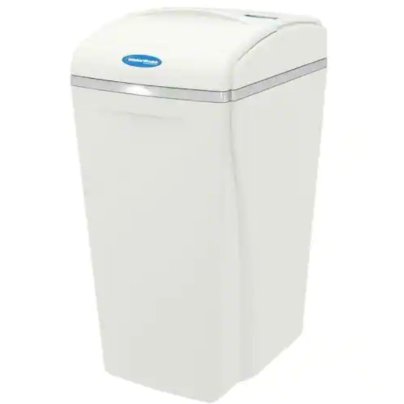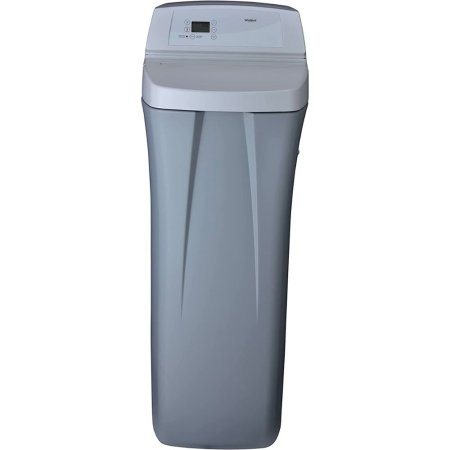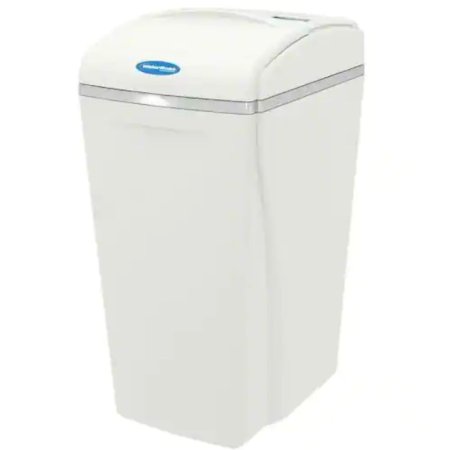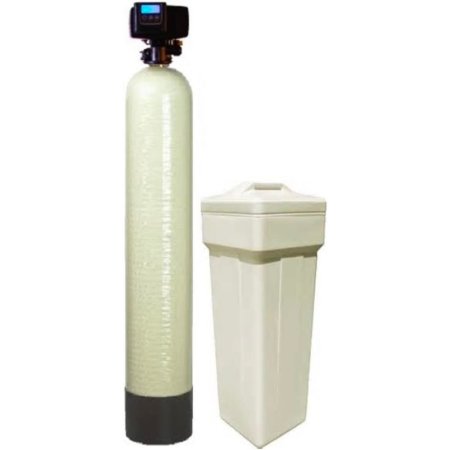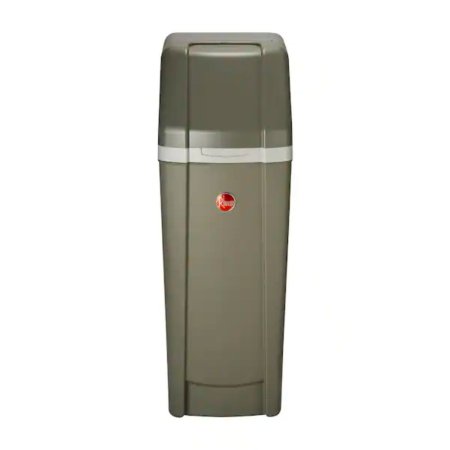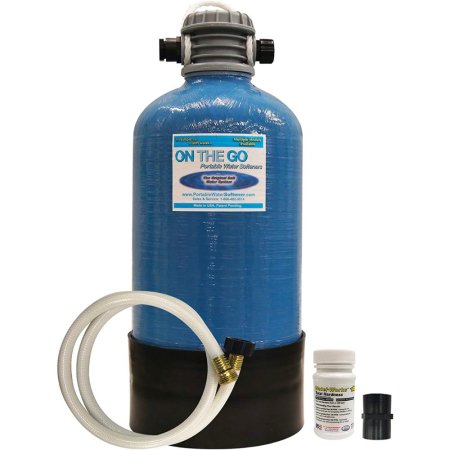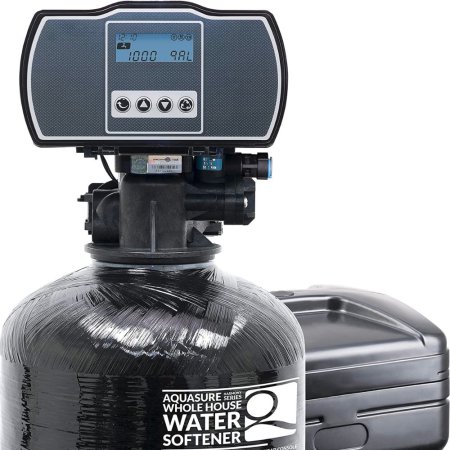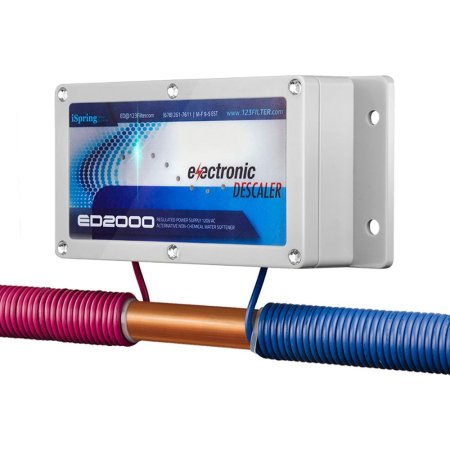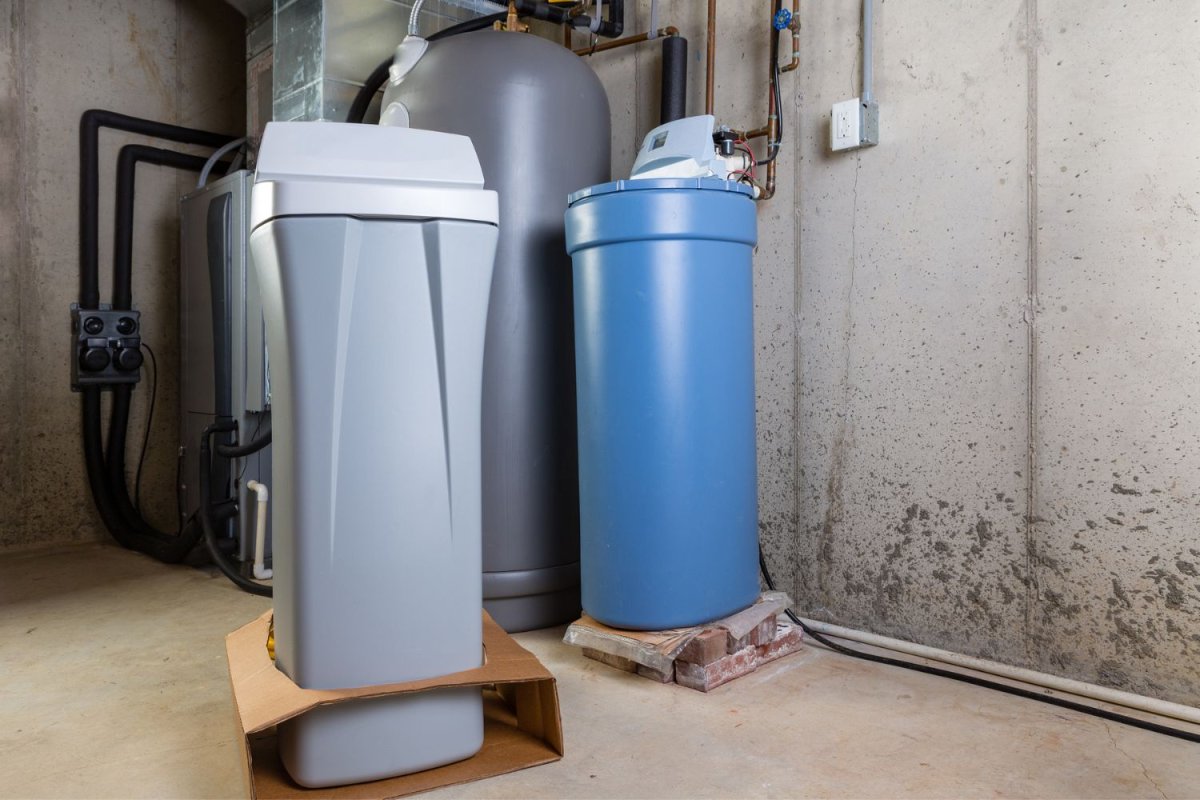
We may earn revenue from the products available on this page and participate in affiliate programs. Learn More ›
Water softeners prevent common problems with water, including chalky deposits of calcium carbonate, called limescale (or scale), and other harsh minerals, like iron and magnesium. These deposits cause hard water, which dries skin and hair. When one of these units is installed in a home, it works to soften water running out of every faucet, reducing or altogether removing these harsh minerals. This improves the quality of the home’s drinking water and leads to healthier skin, hair, and nails.
The best water softeners work by either drawing heavy minerals out of the water using a process called ion exchange or by neutralizing these minerals so that they are unable to bind together and remain soluble in the water.
As a plumbing project manager, I have installed and worked with a wide range of water softeners in both residential and commercial locations. Drawing on this experience, I researched a broad pool of water softener products to find these top options. The Whirlpool 40,000 Grain Water Softener tops this list for its efficiency. But that’s not the only model worthy of taking a look at. Based on their size, capacity, type of water softener, and regeneration cycle, these are some of the best water softeners available.
- BEST OVERALL: Whirlpool 40,000-Grain Water Softener
- BEST BANG FOR THE BUCK: WaterBoss 36,400-Grain Water Softener
- UPGRADE PICK: DuraWater 48,000-Grain Water Softener
- BEST SALT-BASED: Rheem Preferred 32,000-Grain Water Softener
- BEST PORTABLE: On The Go Portable 16,000-Grain Water Softener
- BEST FOR WELL WATER: Aquasure Harmony Series Water Softener
- BEST ALTERNATIVE: iSpring Whole House Water Softener System
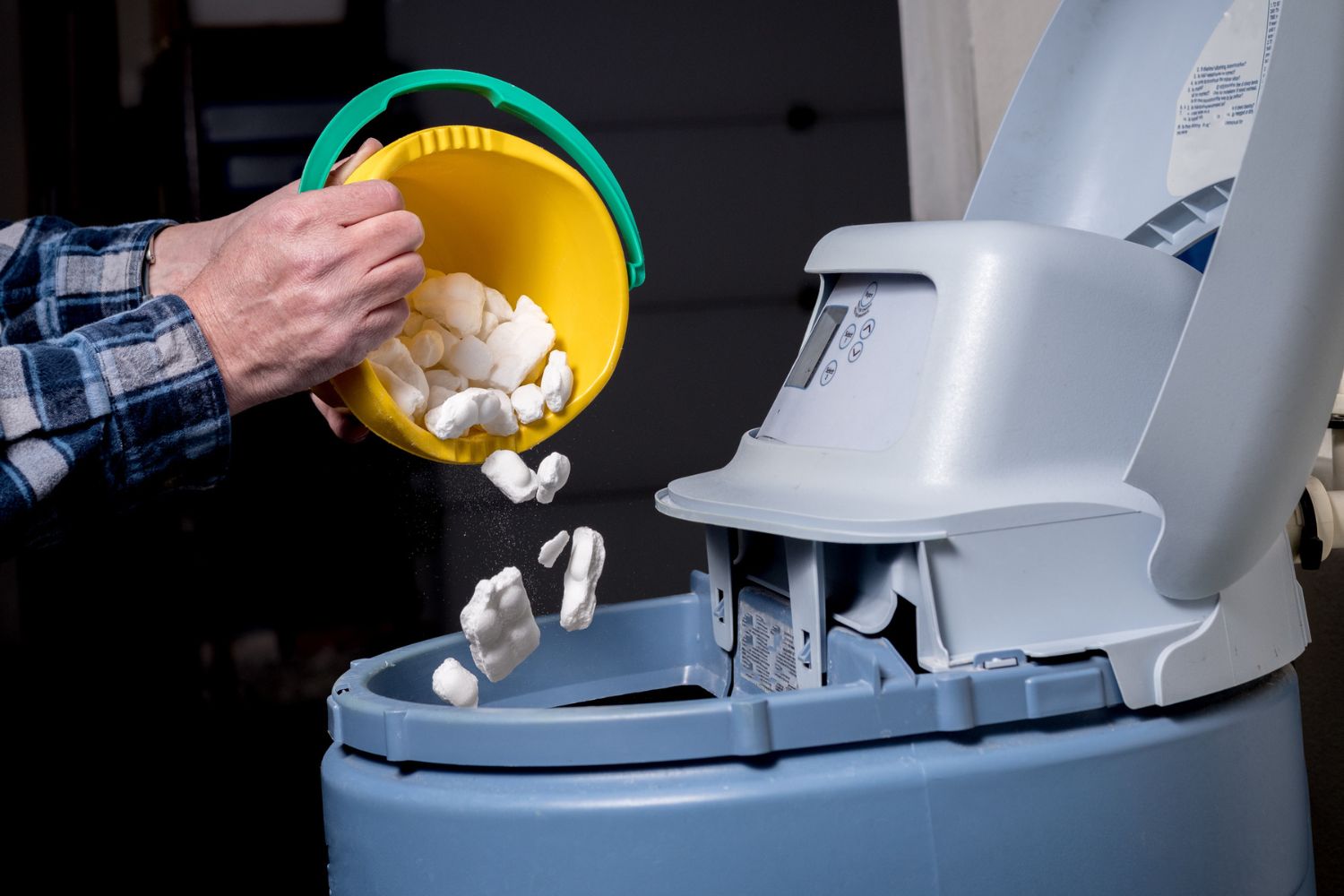
Water Softeners Comparison
| Product | Type | Capacity | Dimensions |
| Whirlpool 40,000-Grain Water Softener | Salt-based water softener | 40,000 grain | 47.875“ x 1″ x 19″ |
| WaterBoss 36,400-Grain Water Softener | Salt-based water softener | 36,400 grain | 25.75″ x 18.75″ x 14.75″ |
| DuraWater 48,000-Grain Water Softener | Dual-tank salt-based water softener | 48,000 grain | 54″ tall by 10″ wide by 10″ |
| Rheem Preferred 32,000-Grain Water Softener | Salt-based water softener | 32,000 grain | 43.5″ x15.25″ x 20.5″ |
| On The Go Portable 16,000-Grain Water Softener | Salt-based water softener | 16,000 grain | 22″ x 9.5″ |
| Aquasure Harmony Series Water Softener | Dual-tank salt-based water softener | 48,000 grain | 62″ x 10″ x 10″ |
| iSpring Whole House Water Softener System | Magnetic water softener | 10 to 19 grains per gallon of water | 3.5″ x 7″ x 2″ |
Our Top Picks
The best water-softener systems remove calcium and magnesium deposits, improving the overall quality of a home’s water. The following water-softening systems are some of the most reliable products in their respective categories.
Best Overall
Whirlpool 40,000-Grain Water Softener
Product Specs
- Type: Salt-based water softener
- Capacity: 40,000 grain
- Dimensions: 48 inches tall by 15 inches wide by 20.5 inches deep
What We Like
- Monitors salt and water usage, regenerating when necessary
- Low-salt tank light makes it easy to know when to refill
- Removes up to 125 grains per gallon of hardness
- Removes 10 parts per million (ppm) of water iron
What We Don’t Like
- Adds salt to the water softener system
- Some users report that resin beads leaked into pipes
Installing this single-tank, salt-based water softener by Whirlpool immediately improves a home’s water quality by removing hard minerals from its water supply. This reduces the extra costs involved in replacing faucets, dishwashers, and other water-based fixtures or appliances due to the premature wear and tear caused by hard water.
Because this Whirlpool water softener treats the problem at the source, the rest of the plumbing isn’t exposed to the hard water. A small amount of salt is added to the water during the ion-exchange process and must be refilled regularly to ensure that salt levels are maintained. This water softener has a capacity of 40,000 grains, and it recharges automatically using a metered system.
Get the Whirlpool water softener at Blain’s Farm and Fleet or Fleet Farm.
Best Bang For the Buck
WaterBoss 36,400-Grain Water Softener
Product Specs
- Type: Salt-based water softener
- Capacity: 36,400 grain
- Dimensions: 25.75 inches tall by 18.75 inches wide by 14.75 inches deep
What We Like
- Treats most municipal water and well-water problems
- Bypass valve extends longevity of the unit
- Rapid regeneration process reduces water consumption
- Includes self-cleaning whole-house water filter
What We Don’t Like
- Add salt as necessary
This water softener by WaterBoss regenerates salt in less than 30 minutes, saving users time and water. An affordable, single-tank, salt-based water softener, it has a capacity of 36,400 grains and is a suitable option for households with four or more people.
This is one of the best water-softener systems available at an affordable price, making it an attractive solution for hard-water problems in average-size homes. It comes with a factory-installed bypass valve, water filter, and a built-in safety shut-off system, making it easier to safely clean the water softener. Just keep in mind that the softener does add salt to the water and this salt does need to be refilled regularly.
Get the WaterBoss water softener at Ace Hardware.
Upgrade Pick
DuraWater 48,000-Grain Water Softener
Product Specs
- Type: Dual-tank salt-based water softener
- Capacity: 48,000 grain
- Dimensions: 54 inches tall by 10 inches wide by 10 inches deep
What We Like
- Fully programmable for various water-treatment applications
- Chlorine-resistant resin offers better filtration while minimizing wear
- Standard brine tank includes safety float and is fitted for quick connection
What We Don’t Like
- Some users report poor water smell and taste
- Some users say the unit doesn’t last long
Despite the premium price of this 48,000-grain-capacity water softener, DuraWater’s model is an excellent investment for a medium to large household. This salt-based water softener removes magnesium, calcium, and even traces of iron to protect pipes, clothing, and hair from the effects of hard water.
A digital LCD screen with touch pad controls the water softener. This allows users to customize the unit’s metered regeneration system to suit their weekly schedules. The display can also be used to view error codes for help troubleshooting. The salt-based softener system weighs 53 pounds and includes a bypass valve and an installation tutorial for handy DIYers.
Get the DuraWater water softener at Amazon.
Best Salt-Based
Rheem Preferred 32,000-Grain Water Softener
Product Specs
- Type: Salt-based water softener
- Capacity: 32,000 grain
- Dimensions: 43.5 inches tall by 15.25 inches wide by 20.5 inches deep
What We Like
- Affordable option for households of up to 4 people
- Features a low-salt indicator light
- Optimizes water usage and regeneration cycles
- High-flow valve maintains water pressure
What We Don’t Like
- Some users complain of missing and damaged parts
This single-tank Rheem water softener optimizes salt consumption, water usage, and regeneration cycles. The tank measures 43.5 inches tall by 15.25 inches wide by 20.5 inches deep. Its metered system only regenerates when necessary, instead of relying on a fixed schedule that may regenerate too frequently or too infrequently to treat the water adequately.
This salt-based Rheem water softener has a capacity of 32,000 grains, making it a good choice for small to average-size households of up to four people. As expected of a salt-based system, a small amount of salt is added to the water in exchange for the heavy minerals. This water softener includes a low-salt indicator light so users know when to refill the salt.
Get the Rheem water softener at The Home Depot.
Best Portable
On The Go Portable 16,000-Grain Water Softener
Product Specs
- Type: Salt-based water softener
- Capacity: 16,000 grain
- Dimensions: 22 inches tall by 9.5 inches in diameter
What We Like
- Provides about 1,600 gallons of soft water
- Regenerates in less than 30 minutes
- Compact design is ideal for camping and travel
- Connects directly to park and campground water supplies
What We Don’t Like
- Some users report having to recharge it frequently
- At 32 pounds, it may be too heavy for some travel
Designed for portability, the On The Go portable water softener is an excellent choice for an RV, a large boat, a small one- or two-person home, or an apartment. An included hose allows for connection directly to an outdoor faucet or campground water supply for instant access to softened water for cleaning, drinking, and bathing.
Intended for portable functionality, this sand-based water softener can be recharged using simple table salt. This is great because the 16,000-grain capacity will require frequent recharging with regular use. However, with the reduced size, there’s a lower price, making this option easier on the wallet.
Get the On The Go water softener at Amazon or On The Go.
Best for Well Water
Aquasure Harmony Series Water Softener
Product Specs
- Type: Dual-tank salt-based water softener
- Capacity: 48,000 grain
- Dimensions: 62 inches tall by 10 inches wide by 10 inches deep
What We Like
- Dual-tank system is a suitable water softener for well water
- 48,000-grain tank optimal for a 2- to 4-bathroom house
- Built-in advanced digital control console allows precise backwashing
What We Don’t Like
- Some users report leaking after a few months
- Some users report salty taste in their water
Aquasure’s dual-tank water softener is known as one of the best hard water softeners for a well system, with a high-capacity 48,000-grain tank that’s suitable for homes with up to five people. The digital control panel allows users to see the time of day, current flow rate, and the volume of soft water or the number of days remaining until regeneration.
This Aquasure water softener works to eliminate iron, magnesium, calcium, and scale. It also has a metered regeneration system that helps to reduce overall salt and water consumption. Just keep in mind that dual-tank systems can take up a lot of floor space.
Get the Aquasure water softener at Amazon, The Home Depot, or Aquasure.
Best Alternative
iSpring Whole House Water Softener System
Product Specs
- Type: Magnetic water softener
- Capacity: 10 to 19 grains per gallon of water
- Dimensions: 3.5 inches tall by 7 inches wide by 2 inches deep
What We Like
- Suitable for use as a whole-house water softener
- Does not add salt to the system
- Made for treating very hard water
What We Don’t Like
- Does not filter out all minerals
- Not suitable for larger homes due to limited 50-foot range
The iSpring ED2000 water descaler is an affordable solution for treating scale buildup in appliances, on faucets, and on shower heads. Like all electronic magnetic water softeners, it does not remove heavy minerals from water, so clothing may still suffer from premature fading. However, whole-house water-softener reviews for this descaler indicate its effectiveness at treating mineral buildup.
This top whole-house water softener is easily installed on all types of pipe, including PEX and PVC, by wrapping the two antenna cables from the water softener around the water pipe and then plugging the unit into a power outlet. The neutralized soft water doesn’t just prevent scale buildup; it breaks down existing scale to give the home a cleaner look and feel.
Get the iSpring water softener at Amazon, Lowe’s, or Walmart.
Jump to Our Top Picks
How We Chose the Best Water-Softener Systems
Water-softening systems aren’t widely known products like lawn mowers or cars, so it can be difficult for shoppers to judge the best ones. However, years of plumbing industry experience and extensive research into the types of water softeners helped us compile our list of top-rated water systems.
Key considerations included the type of soft water system, the capacity of the product, the suitability of the softener for various family sizes, the water softener companies buyers choose, and any outstanding features that made a water softener stand out from similar products.
Most water-softener systems are salt-based. That’s why a high number of salt-based systems were selected, including both single-tank and dual-tank products. Capacity and suitability were typically considered together because in most cases, a large family will require higher-capacity water softener systems. Also, metered systems from top water-softener brands were generally favored, simply because this design helps conserve water and only regenerate when necessary.
What to Consider When Choosing a Water-Softener System
While choosing a house water softener, shoppers may want to take a few minutes to learn about the most important considerations to keep in mind, including type, capacity, available area to install the water softener, whether or not it has a bypass valve, and the length of its regeneration cycle. Here’s a closer look at some important features included with today’s water softeners.
Types of Water Softeners
There are four main types of water softeners: salt-based, salt-free, dual-tank, and magnetic water softeners. The cost of a good water softener generally falls between the affordable magnetic units and the pricier salt-free options. Before buying a water softener unit, shoppers should familiarize themselves with the types of water softeners available and determine which one best suits their needs.
Salt-Based Water Softeners
Salt-based water softeners are available in several sizes and are appropriate for just about every dwelling, from RVs to mansions. These water softeners remove heavy minerals, like calcium and magnesium, from drinking water through an ion-exchange process. During the process, minerals are drawn into a resin within the softener and are exchanged for sodium ions (salt). This makes a home’s drinking water healthy and neutral so that it doesn’t damage appliances and faucets or dry out skin and hair.
While salt-based water softening systems do add salt to the water, it is such a small amount that it frequently goes unnoticed. The downside to salt-based softeners is that the positively charged sodium ions in the resin do run out and need to be recharged with salt about once a week. These water softeners are also much larger than magnetic or salt-free water softeners, so they aren’t ideal for smaller spaces.
Salt-Free Water Softeners
Salt-free water softeners don’t soften water; they condition it instead. This is done by crystallizing mineral ions so they don’t form scale with the plumbing.
Salt-free water softeners have a template-assisted crystallization system consisting of polymeric beads that hold microscopic nucleation sites. When heavy minerals attach to these sites, they begin to form into crystals through a neutralization process. Once established, the crystals detach and do not bond to anything, preventing mineral buildup to soften water.
Salt-free water softeners tend to cost more initially but last for around 3 years without electricity or recharging required. These models are also smaller than salt-based water softening systems, so they can be used for small- to large-size houses without issue. However, salt-free water softeners may struggle with very high levels of hard water and households with higher-than-average water usage.
Dual-Tank Water Softeners
A dual-tank water softener is salt-based and has two resin tanks, making it the best kind for homes that rely on well water. When one of the tanks is in the regeneration cycle, the other is still providing softened drinking water to the household.
Dual-tank softeners aren’t necessary for most homes, and due to their size, they can be challenging to install. They also carry a higher price tag than other water-softener types and do need to be recharged. However, a dual-tank water softener can handle more water per regeneration cycle and never run out of softened drinking water.
Magnetic Water Softeners
Magnetic or electric water softeners are great for small spaces, as they sit on a water pipe and take up almost no space at all. While there’s no need to cut into the water line to use them, certain models do have to be wired into a home’s electrical system. However, once installed, the best electronic water softener available will work fine without having to worry about accidentally pulling the plug.
These water softeners don’t remove heavy minerals from the water. Instead, they use a magnetic field to strip negative or positive ions from heavy minerals, neutralizing them. Once they are no longer positively or negatively charged, the minerals cannot bond to each other and remain entirely soluble in the water.
An affordable choice, magnetic water softeners are the best option for those experiencing light to moderate hard-water issues.
Capacity
Capacity is the measurement of grains per week that a water softener can handle before needing replenishment.
Water softness and hardness are measured using grains per gallon (gpg), where 1 grain is equal to 0.002 ounces of calcium carbonate dissolved in 1 gallon of water.
- 0 to 3 gpg is considered soft water.
- 3.5 to 7 gpg is considered moderate and ideal.
- 7.5 gpg or greater is regarded as hard water and should be treated with a water softener.
Small water-softening systems have weekly grain capacities of 16,000; 24,000; and 32,000 and are ideal for RVs, apartments, and small houses. Those with grain capacities of 40,000; 48,000; and 64,000 are great for medium to large households. For big families and large properties, a residential water softener with a grain capacity of 80,000 or 100,000 works best.
Available Area
Before buying, shoppers will want to measure the area where the water softener will be installed and compare it to the manufacturer’s installation specifications if space is a concern.
Salt-based and dual-tank water softeners, for example, can take up a lot of space and are best for medium to large homes. By contrast, most salt-free water softeners are smaller than salt-based models and are suitable for small, medium, and large households. Portable salt-based water softeners are an alternative option for small homes or RVs that prefer a salt-based model to remove heavy metals entirely.
Magnetic water softeners take up the least amount of space and can be installed without cutting into plumbing. Typically, these smaller softeners can be mounted directly on the pipe and do not interfere with floor space. These softeners are the best option to save space in smaller homes, RVs, or apartments.
Bypass Valve
A valve controls the flow of water through a pipe, closing, or opening when necessary. A bypass valve works in the same way as a regular valve, but its purpose, when used with a water softener, is to divert the flow of water away from the softener, providing access to the hard water running into the home.
This feature may seem pointless to some shoppers, but a bypass valve can save time and money by preventing the water softener from using excess salt or energy to soften the water used for watering the lawn or washing the deck. If it’s going to be used for these purposes, the bypass valve will divert the flow of water around the softener and back into the pipes. Once complete, the bypass valve can be closed, restoring the flow of water through the softener.
Regeneration Cycles
Salt-based water softeners must be regenerated or refreshed when users add salt or begin a regeneration cycle. This can be regulated using a metered system or with a timed system.
- Metered water softeners work by counting the gallons of water that pass through the water softener and automatically regenerating when necessary. This system is great for vacation homes or cottages with long periods of disuse because the system will only regenerate when it has to.
- Timed water softeners are set to regenerate the salt within the softener automatically at a designated time. These softeners allow for more control over the scheduled regeneration but will use more salt than necessary if the regeneration intervals are too short. This system could also result in hard water passing through the pipes if the regeneration intervals are too long.
The Advantages of Owning a Water Softener
Water softeners are an excellent option for homes with light to heavy hard water, which can result in clogged pipes and leaky faucets and can degrade water-based appliances. The heavy minerals detected in hard water tests also prevent moisture permeation in hair and skin and can cause colors to fade in the washing machine and items to come out of the dishwasher looking chalky or spotted.
A water softener solves all of these issues by preventing heavy minerals from binding or flowing through the water. With softened water, the moisture and “life” returns to skin and hair. It also prevents clothes from wearing out prematurely and leaves dishes looking and feeling clean, which cuts down on cleaning time. These hard water treatment systems can:
- Save money in the long term
- Nourish hair and skin
- Brighten and soften clothes
- Clean dishes better
- Reduce time spent cleaning
Tips for Using a Water Softener
After installing a water softener, its salt levels should be checked every 4 to 6 weeks. If the salt level drops, then hard water will begin to return to the home’s water system.
While checking salt levels, the condition of the brine tank should also be checked, as salt bridges may have formed over time. These bridges can prevent the resin beads from softening the water properly and must be cleared to ensure the proper functionality of the water softener. Here are a few more tips to consider:
- Use the correct salt in the water softener. This is key to maintaining the unit’s functionality. User manuals usually specify the right kind of salt to use.
- Flush the resin bed with a water-softener cleaner regularly. This can help remove iron and other heavy metals from the beads, allowing them to regenerate with salt properly.
- After cleaning the unit, properly discard excess salt. A water-softener user should consider disposing of excess brine by diluting it with equal parts water, stirring vigorously, then slowly pouring it down a kitchen sink drain. Run the water before and after dumping to ensure brine is properly flushed.
FAQs
Our guide addressed most of the questions and concerns shoppers have while looking for the best water-softening system for their homes. Sometimes, additional questions crop up, particularly those involving filtration-system usage and regular maintenance. Here are answers to some of the most frequently asked questions about water softeners.
A water softener removes harsh minerals like calcium and magnesium from a home’s water supply. The resin beads inside these systems trap the calcium and magnesium and convert them to potassium and sodium. Essentially, this exchange makes household water gentler on skin, hair, and clothes.
Empty the contents of the water softener and scrub the empty tank with soapy water. Rinse and fill with 0.25 cups of bleach and water. After 15 minutes, rinse. Replace brine grid. Fill tank with water, replenishing salt.
Yes, it’s safe to drink water from a water softener if the only contaminants are hardening minerals. It won’t remove any other harmful particles, though. For completely safe water from the tap, try an under-sink water filter.
Copper pipes are vulnerable to heated and softened water and could cause corrosion and pinhole leaks in your system. Over time, minerals could build up on the copper and cause these leaks to occur.
The average water softener lasts between 10 and 15 years. With proper maintenance and care, it can last longer than that without requiring a replacement. Another option for lengthening the life of your water softener is a prefilter, which prevents sediment and materials from building up and causing malfunctions.
Soft water has a high sodium content and is not recommended for daily consumption. Pipes can also be affected if minerals and other elements build up over time.

